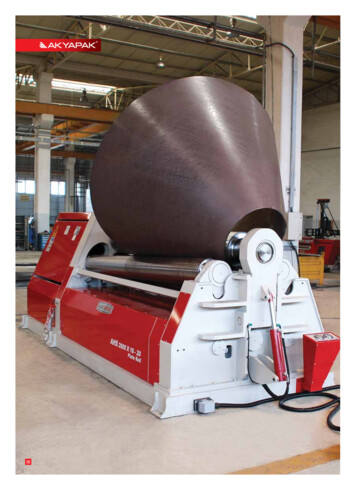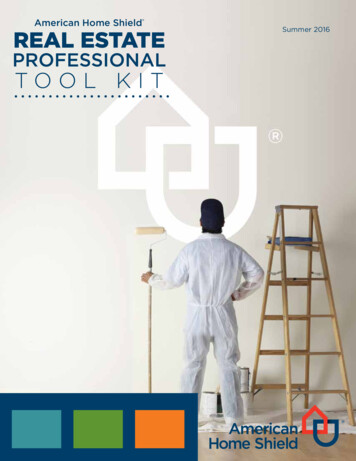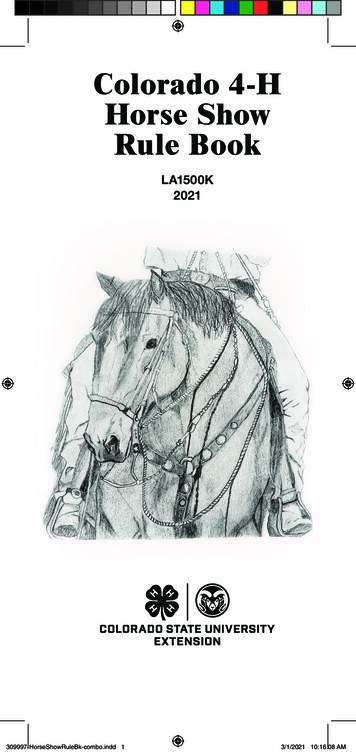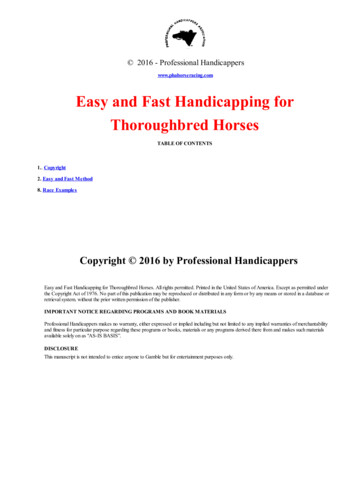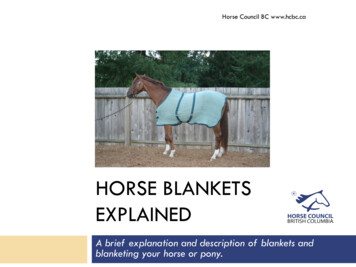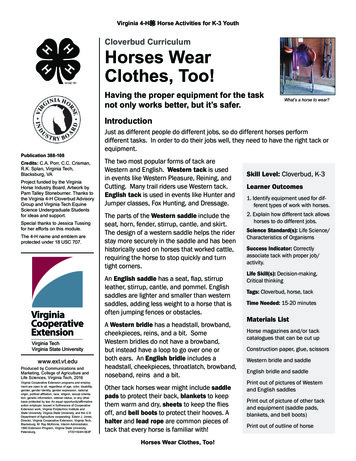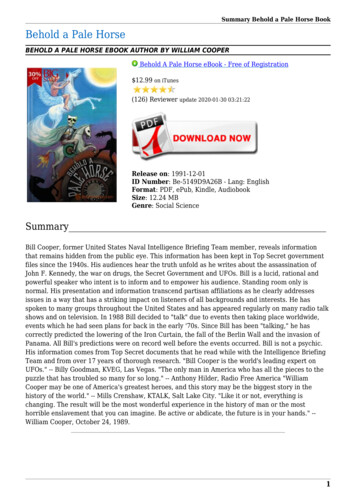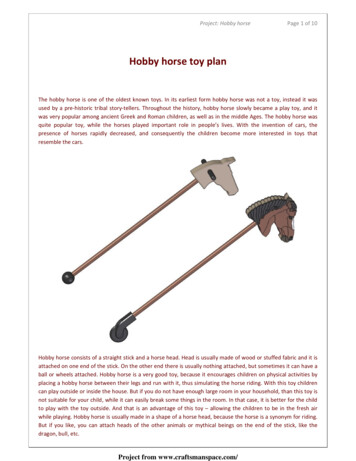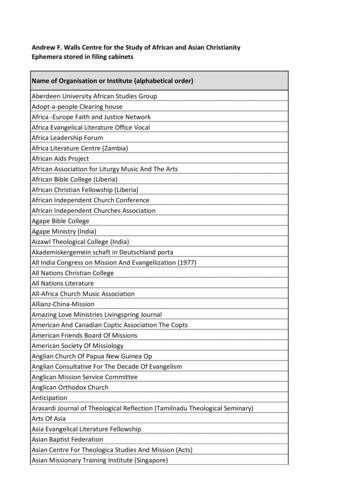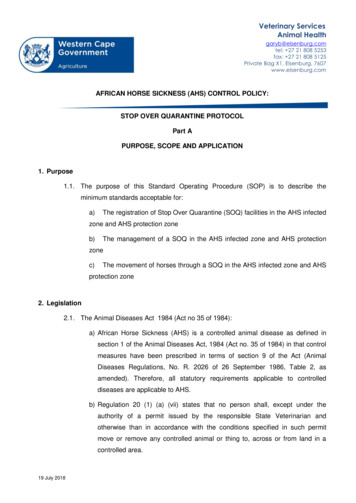
Transcription
Veterinary ServicesAnimal Healthgaryb@elsenburg.comtel: 27 21 808 5253fax: 27 21 808 5125Private Bag X1, Elsenburg, 7607www.elsenburg.comAFRICAN HORSE SICKNESS (AHS) CONTROL POLICY:STOP OVER QUARANTINE PROTOCOLPart APURPOSE, SCOPE AND APPLICATION1. Purpose1.1. The purpose of this Standard Operating Procedure (SOP) is to describe theminimum standards acceptable for:a)The registration of Stop Over Quarantine (SOQ) facilities in the AHS infectedzone and AHS protection zoneb)The management of a SOQ in the AHS infected zone and AHS protectionzonec)The movement of horses through a SOQ in the AHS infected zone and AHSprotection zone2. Legislation2.1. The Animal Diseases Act 1984 (Act no 35 of 1984):a) African Horse Sickness (AHS) is a controlled animal disease as defined insection 1 of the Animal Diseases Act, 1984 (Act no. 35 of 1984) in that controlmeasures have been prescribed in terms of section 9 of the Act (AnimalDiseases Regulations, No. R. 2026 of 26 September 1986, Table 2, asamended). Therefore, all statutory requirements applicable to controlleddiseases are applicable to AHS.b) Regulation 20 (1) (a) (vii) states that no person shall, except under theauthority of a permit issued by the responsible State Veterinarian andotherwise than in accordance with the conditions specified in such permitmove or remove any controlled animal or thing to, across or from land in acontrolled area.19 July 2018
3. Definitions and Abbreviations3.1. AHS” African horse sickness3.2. “AHS Movement Permit” is an official written permission, including all associatedand/or stipulated conditions, issued by the responsible SV, required for an equid tomove to a zone of higher AHS control or out of an outbreak area. In terms ofRegulation 20 (5), the delegated responsible SV for issuing the Movement Permit forAHS movement control purposes is the SV: Boland.3.3. “Certification by a veterinarian” must include the signature of the veterinarian, theveterinarian’s full name, qualification and practice stamp/address.3.4. “Equid, Equidae” means and includes all members of the genus Equus andincludes horses, donkeys, zebra, onagers and kiangs as well as their hybrids.3.5. “Equine” means horses, mules, donkeys and their hybrids as defined in the AnimalDiseases Act 1984 (Act no 35 of 84). This excludes zebra (Equus quagga andEquus zebra) and their hybrids.3.6.“Veterinarian” means a qualified veterinarian according to the Veterinarians andPara-veterinarians Professions Act 1982 (Act no 19 of 82) and registered with theSouth African Veterinary Council.3.7. “Low risk area” means an area where the historical incidence of outbreaks of AHSis low; the local state veterinarian is satisfied with the reporting of equine diseases inthe area; and there has been no suspect or confirmed case of AHS recorded withina radius of 30 km in the previous 40 days.3.8.“Passport” is the identification document that positively identifies the equine. Theformat of the passport must comply with the minimum standards as set out in theAHS control SOP: Acceptable identification of equines.3.9. “Registered Equine” means an equine identified by means of a passport that iscompliant with the AHS control SOP: Acceptable Identification of Equines issued bya Passport Issuing Agency as defined in the SOP.3.10. “Stop-Over Quarantine facility” means a specific holding situated in an AHS lowrisk area, approved by SV: Boland for this purpose. Horses are held at the StopOver Quarantine according to the protocol as described in the AHS control SOP:Page 2 of 2317 July 2018
Standards for the registration and management of a Stop Over Quarantine Facilityfor a minimum of 14 days and tested to prove they are free of AHS virus before theyare allowed to move to the AHS controlled area.4. Application4.1. This SOP is applicable to:a)All facilities that are registered or wish to be registered as a SOQ for AHSmovement control purposes.b)All state veterinarians (SV’s), veterinarians and other officials involved in theinspection, registration and monitoring of SOQ’s for AHS movement controlpurposes.c)All owners, managers, and other role-players who are involved in theregistration, management and operation of a SOQ for AHS movement controlpurposes.d)All owners and transporters who make use of, or transport horses to or froma SOQ facility.5. Scope5.1. The aim of a SOQ is to facilitate movement of registered horses into the AHScontrolled area from the AHS infected area:a)Where an AHS movement permit cannot be issued for direct movement ofhorses due to the AHS risk status of the area of origin.b)Where a horse has not been vaccinated against AHS according to therequirements set out for the movement of registered horses in the latest officialversion of the Movement Protocol for African horse sickness Control available onthe Elsenburg website; or a horse has not been vaccinated in accordance withthe AHS vaccine manufacturer’s recommendations. A horse that has beenvaccinated in the AHS infected area less than 40 days before movement, maynot move into the AHS controlled area through a SOQ facility.Page 3 of 2317 July 2018
c)Where an imported horse that is not subject to post-importation quarantineat point of entry has not undergone a 60 day residency period in the AHS infectedzone of South Africa.d)Any other equine directed to undergo SOQ prior to movement into the AHScontrolled area by the SV: Boland or the Director: Animal Health at DAFF (DAH).Page 4 of 2317 July 2018
Part BPROCEDURE FOR REGISTRATION OF A STOP OVER QUARANTINE FACILITY1. GeneralSOQ facilities for AHS must be approved by and registered with SV Boland for this purpose.SOQ facilities must be situated in the AHS protection zone or low risk areas within the AHSinfected zone.SOQ facilities, although approved and monitored by state veterinary authorities, are not stateowned enterprises and are constructed, maintained and managed commercially by privateindividuals.The state veterinary services are not responsible for any costs associated with the SOQ or SOQprotocol, i.e. all costs are incurred at the owner’s expense.The state does not have any influence on the fees charged by SOQ facilities.The manager of the SOQ is responsible for ensuring that the SOQ protocol is followed.The manager of the SOQ is responsible for the welfare and care of the horses at the SOQ facility.The registration of a SOQ facility is valid for one year and registration must be renewed annually.2. Application to register a SOQ Facility2.1. The owner/manager of the facility must apply in writing to the SV: Boland, for theregistration or renewal of registration of a SOQ facility. The application will beassessed by SV: Boland in collaboration with the local state veterinarian.2.2. The documents listed below must be presented to SV: Boland on application forregistration:a) “SOQ Facility Application for Registration or Re-registration”, available fromSV: Boland, must be completed and signed by the applicant (owner/manager),the applicant/owner’s appointed private veterinarian and the local stateveterinarian responsible for verifying the AHS risk status of the area andsupervision of the SOQ facility.b)“SOQ Manager Authorisation” appropriate for the type of SOQ facility (i.e.vector protected SOQ in the protection zone or SOQ in the infected area),Page 5 of 2317 July 2018
available from SV: Boland, must be completed and signed by the applicant(owner/manager) responsible for the maintenance and management of the SOQfacility.c)A clearly marked site plan. The purpose of the site plan is to assess thefunction as a SOQ, the proximity of other equidae and the risk of potential vectorbreeding sites. The site plan must indicate:i.Where the proposed SOQ facility will be situated on the holding as well asthe surrounding structures on the premises, particularly structures within200m of the stable facility where the horses in SOQ will be housed duringthe high vector activity period of the day;ii.Boundary fences, access points, loading areas, roads and any rivers,marshy or vlei areas that could be a breeding site for large numbers ofmidges;iii.The known farming or business activities involving equidae conducted onthe neighbouring properties;iv.The species and estimated number and proximity of other equidae on theholding and equidae on neighbouring properties;v.A more detailed plan of the stabling facility and paddocks that will be usedto house horses under the SOQ protocol.2.3. A standard operating procedure (SOP) for operation of the SOQ, including stafftraining and access control.2.4. A standard operating procedure (SOP) in the case of a suspicion of an infectiousdisease in a SOQ horse or in the case of a positive AHS test result on day 14 ofSOQ.2.5. A standard operating procedure (SOP) for transport to a veterinary hospital foremergency veterinary care. The name, address and contact details of the veterinaryhospital must be included. If the veterinary hospital is situated in the AHS controlledarea, the veterinary hospital must have a vector protected isolation facility and beable to manage the horse under vector protected conditions. The horse must remainat the veterinary hospital under vector protected conditions for the balance of the 14day SOQ period, or may be returned to the SOQ facility where possible. The horsemay only move to a veterinary facility within the AHS controlled area with permissionfrom SV: Boland.Page 6 of 2317 July 2018
2.6. Application for registration of a SOQ facility must be submitted at least two monthsprior to intended use of the facility for AHS control purposes.2.7. Application for re-registration of a SOQ facility must be submitted at least twomonths prior to expiry of a previous registration.3. Inspection to Approve a SOQ3.1. If the site and stabling plans indicate the facility may be suitable for registration, theSOQ facility will be inspected by SV: Boland. SV Boland may delegate this functionto the local state veterinarian or an authorized official.3.2. The owner/manager of the SOQ facility and the inspecting official must agree upona suitable date for the inspection.3.3. The basis for approval will be compliance with the requirements as described in thisSOP. The inspecting official will inform the owner/manager of the SOQ facility of anyadditional information that may be required for the inspection.3.4. Records of all correspondence, standard operating procedures, registers, checklistsand inspection reports must be kept for auditing purposes by the manager of theSOQ facility and SV: Boland.3.5. The inspecting official will be responsible for the following actions/procedures:a)Consultation with the local state veterinarian and SV Boland regardingthe AHS risk status and suitability of the holding based on:i.Historical incidence of AHS from published information or local SV personalknowledge,ii.Consideration of disease reporting, relevant environmental factors andequid populations in the area in relation to AHS risk,iii.The assessed administrative capabilities of the manager and theoperational suitability of the holding.b)i.Inspection of the potential SOQ facility according to this SOP to confirm that:The SOQ facility and holding complies with the requirements andconditions of this SOP and any additional requirements as deemednecessary by SV: Boland or the local state veterinarian;Page 7 of 2317 July 2018
ii.The standard operating procedures and registers for the facility areavailable and comply with the requirements for a SOQ facility;iii.The facility and holding corresponds with the site and stable plansprovided.c)Completion of the SOQ Facility Inspection Report obtained from SV: Bolandwith descriptive comments within 10 working days of the inspection. Theinspection report must be forwarded to the owner of the SOQ facility and SV:Boland.3.6. If the SOQ facility does not comply with the requirements of this SOP or is deemedunsuitable for any other reason:a)The inspecting official must provide the owner/manager and SV: Bolandwith a detailed report with the reasons why the SOQ facility cannot beapproved.b)If relevant, the inspecting official must arrangeforanotherinspectionwhen the owner/manager indicates that all the deficiencies identified havebeen rectified.3.7. If the SOQ facility is found suitable and compliant with the requirements of this SOP,SV Boland will issue the registration certificate. The original certificate will be sent tothe owner/manager, a copy will be sent to the local SV and a copy will be filed forauditing purposes.4. Listing of a SOQ for AHS Movement Control4.1. All registered SOQ’s must be listed in an official "List of Registered Stop OverQuarantine Facilities" compiled and regularly up-dated by SV: Boland.4.2. The list of registered SOQ facilities must contain the following information for eachSOQ facility:a)Registration number of facility as assigned by SV: Bolandb)Registered name and address of the SOQ facilityc)Type of SOQ facility, i.e. SOQ in the protection zone or SOQ in the infectedareaPage 8 of 2317 July 2018
d)Name, contact telephone numbers and an email address of theowner/manager of the SOQ facilitye)Name, contact telephone numbers and an email address of the person atthe SOQ facility who will be responsible for bookings (if different from theowner/manager)f)Name, contact telephone numbers and an email address of the local .5. Re-Registration of a SOQ facility5.1. The registration of a SOQ facility is valid for a period of 1(one) year.5.2. The owner/manager of a registered SOQ facility must contact SV: Boland in writingand complete the –“SOQ Facility Application for Registration or Re-registration,available from SV: Boland, at least two months before the expiry date of theregistration certificate, to arrange for a re-inspection of the SOQ facility.5.3. Copies of site and stable plans need not be submitted annually, unless there aremajor structural changes that have taken place.5.4. Copies of inspection reports with check lists and SOP’s evaluated during theinspection and a record of all correspondence must be kept for auditing purposes bythe owner/manager of the facility and SV: Boland.5.5. SOQ facilities may only be re-registered once the application for re-registration hasbeen received, evaluated and approved by SV: Boland.5.6. Re-registration applies to the annual re-registration of SOQ facilities. It does notapply to a new application or to facilities that have had their registration revoked forany reason or where registration has lapsed.Page 9 of 2317 July 2018
6. De-Registration of a SOQ6.1. The registration of the SOQ facility can be withdrawn at any time, at the discretion ofthe SV: Boland and the local SV, if there is a change in the AHS risk status of thearea or if any shortcomings or non- conformances are detected.6.2. If a SOQ facility has not been re-inspected and re-registered prior to the end of theone year registration period, the facility will automatically be de-registered on thedate of expiry.6.3. The registration of an SOQ facility will be withdrawn if the manager of the SOQfacility is changed without prior notice and consultation with SV: Boland.Page 10 of 2317 July 2018
Part CREQUIREMENTS FOR A SOQ FACILITYIf the SOQ facility is situated in the AHS Protection Zone, additional requirements as detailedunder Part E in this SOP: Additional Requirements for a SOQ in the AHS Protection Zone, apply.1. General Structural Requirements for A SOQ Facility1.1. The SOQ facility should not be located within 200m of vleis, rivers, animal housing,compost heaps, standing water and landfill sites that are likely midge breeding sites.This includes all areas where SOQ horses are stabled, handled, grazed or worked.1.2. A warning sign must be placed at the entrance to the SOQ facility, indicating that itis a quarantine area.1.3. The stable building must be a solid structure with floors that are easy to clean anddoors that can be closed.1.4. The SOQ stables, camps, work areas and loading facilities must be of suitablerepair and construction to ensure the smooth functioning of the facility, safety of thehandlers and welfare of the horses.1.5. Good drainage must be available to prevent pools of standing water after rain orcleaning to limit potential breeding sites for vectors.1.6. Disposal methods for garbage/waste of all kinds and discarded equipment must limitthe formation of midge breeding sites and must be in accordance with all relevantrequirements of South African law.1.7. An office must be available at the SOQ facility for safe and orderly storage ofrecords.2. General Management Requirements for A SOQ Facility2.1. The SOQ facility must be managed in accordance with Part D: “Protocol formovement through a SOQ facility”.2.2. Horses must be individually identified before the start of the SOQ period with apassport that complies with the requirements of the AHS control SOP: Acceptableidentification of equines. The passport must accompany the horse at all times.Page 11 of 2317 July 2018
2.3. All standard operating procedures and registers specified under Part B: “Procedurefor Registration of a Stop Over Quarantine Facility” and Part D: “Protocol formovement through a SOQ facility” must be kept by the owner/manager of the SOQfacility in an auditable format and be readily accessible at the facility to the localstate veterinarian, consulting private veterinarian or SV: Boland, even if theowner/manager is not present.2.4. Standard operating procedures and registers must be kept for a period of two yearsor from registration of the facility if registration occurred less than 2 years previously.2.5. A veterinary hospital must be nominated by the SOQ facility manager for referral ofany horses that may require in patient emergency treatment.If the veterinaryhospital falls within the AHS controlled area, the hospital must have an approvedisolation facility that is vector protected.2.6. No unauthorized persons may be allowed entry into the SOQ facility.2.7. The SOQ horses must be managed and housed separately from any residentequines on the property or, where separate housing is not possible, the residentequines must be managed under the same conditions as the horses in SOQ.2.8. SV Boland must be informed immediately if there are major structural changes tothe facility or holding or if there are any management changes at the SOQ as thesechanges may necessitate suspension of the registration of the SOQ until reinspection and re-approval has occurred.2.9. SV: Boland must be informed of any known changes in the activities on the SOQholding and neighbouring holdings that involve equidae.2.10. The local state veterinarian and SV: Boland must be immediately informed of anysuspect or positive cases of AHS in the area.Page 12 of 2317 July 2018
Part DPROTOCOL FOR MOVEMENT THROUGH A SOQ FACILITY1. The owner/manager or agent of the horse must apply to SV: Boland for movement through aSOQ facility. A movement permit application form must be completed in full and sent tomove@myhorse.co.za before the horse is moved to the SOQ facility.2. The owner/manager or agent of the horse must book directly with the SOQ manager andensure confirmation of the booking is received, i.e. booking space at the SOQ is theresponsibility of the owner/manager or agent of the horse and not the local state veterinarian orSV: Boland.3. The SOQ manager, local state veterinarian or SV: Boland may require additional risk mitigationin the form of a negative RT-PCR test for AHS, run at a DAFF approved laboratory beforehorses may enter the SOQ facility.4. The SOQ may operate an “all in all out” system at the discretion of the local SV, SV: Bolandand/or the SOQ manager.5. The SOQ manager must notify the local SV and SV: Boland by email to move@myhorse.co.zaof the arrival of the horse. The arrival notification email must include the name of the horse,passport number and/or microchip number, date and time of arrival, estimated date ofdeparture and confirm the horse appears clinically healthy.6. Day 1(one) of the SOQ period will only start after SV: Boland has given written permission forthe SOQ period to start. SV: Boland will only confirm the start of the SOQ period if:a)The SOQ manager has provided all the required details in the written notification of thearrival of the horse received by SV: Boland.b)The AHS movement permit application with all supporting documentation has beenreceived by SV: Boland and is compliant.7. Each horse must spend at least 14 continuous, consecutive days in SOQ. Horses in SOQquarantine may not leave the SOQ facility during the SOQ period.8. Once in SOQ:a)Horses must be stabled continuously from two hours before sunset to two hours aftersunrise.b)A vector repellent and insecticide registered under the Fertilizers, FarmFeed,Page 13 of 2317 July 2018
Agricultural Remedies and Stock Remedies Act, 1947 (Act No.36 of 1947) (e.g. DEET15% solution) must be applied to preferred midge biting sites, i.e. head, neck, back,tail base and belly:i.Before the horse enters the SOQ stable on the first day of SOQ andii.Before the horse exits the stable each day andiii.The vector repellent and insecticide must be reapplied according to themanufacturer’s instructions throughout the period the horse is outside thestable.c)The rectal temperature of the horse must be taken and recorded twice a day, in themorning and evening.d)Any above normal rise in temperature or any other clinical signs that may be indicativeof an infectious disease must immediately be reported to the local state veterinarianand SV: Boland. This notification should be followed with a notification in writing within24 hours.9. The manager of the SOQ must ensure the following registers are kept and made available tothe local state veterinarian, consulting private veterinarian and SV: Boland on request:a)A register of staff training and education of visitors.b)An access control register for staff, veterinarians and all visitors.c)A register of all horse/s undergoing SOQ for traceability purposes. Horse details mustbe recorded including the horse name, passport number, microchip number, details ofthe last set of AHS vaccinations (batch, date and administering veterinarian), place oforigin, date of arrival at the SOQ premises, date of the start of SOQ, testing date,result, laboratory reference number, departure date and destination.d)A register of the temperatures for each horse in SOQ, taken and recorded twice daily,in the morning and in the afternoon.e)A register of the date and time each horse was allowed out of the stables and returnedto the stables during the SOQ period.f)A register of each application of insecticide inside the facility and on the horse with thename of the product, batch number and expiry date.Page 14 of 2317 July 2018
g)A register of each application of repellent on the horse with the name of the product,batch number and expiry date.h)A register describing any abnormalities or break in SOQ protocol, e.g. transport to aveterinary hospital for emergency care or if a horse escapes. If horses are removed forany reason during the SOQ period, the local SV and SV: Boland must be informed bythe SOQ manager immediately, and within 24 hours in writing.i)A register of disease investigations and veterinary care required for any horse in SOQ.Any clinical condition or temperature of the horse that may be suggestive of aninfectious disease must be reported to the local SV and SV: Boland immediately, andwithin 24 hours in writing.10. A minimum of 14 days after the official start of SOQ and as long as there has been no break inquarantine and no suspicion of AHS, a blood sample must be drawn by a veterinarian orauthorised para-veterinary professional and submitted to a DAFF approved laboratory for AHSRT-PCR testing.a)Samples may not be collected prior to day 14.b)The laboratory should be contacted for their preferred sampling, packaging andtransportation.c)The laboratory submission form must be completed in full and must note that the test isfor movement under the SOQ protocol.d)On the day of sampling, the private veterinarian must check the temperature logs forthe horse and advise SV: Boland if the temperature logs are not complete or if anyirregularities were recorded.11. SV Boland will only consider issuing a permit for the movement of the horse from the SOQ tothe AHS controlled area if:a)Permission was granted by SV: Boland in writing for the start of the SOQ periodb)There has been no break in SOQ and there is no indication that there were anyirregularities during SOQc)SV: Boland received written negative AHS test resultsd)The AHS risk status of the area remained low risk for the preceding 40 days.Page 15 of 2317 July 2018
12.The private veterinarian must complete the health certificate for movement (HCM) in thepassport and pre-notify SV: Boland of the movement of the horse into the AHS controlledarea.Page 16 of 2317 July 2018
Part EADDITIONAL REQUIREMENTS FOR A SOQ IN THE AHS PROTECTION ZONE The registration of a SOQ in the AHS protection zone will only be considered if the stablefacility is vector protected according to the minimum standards set out in this SOP andthe horses in the facility are managed under vector protected conditions, as described inthis SOP. All of the structural, management and procedural requirements for a SOQ in the infectedzone apply to a SOQ in the AHS protection zone. Additional requirements for a SOQ inthe AHS protection zone are listed below. . An AHS movement permit issued by SV: Boland is required for movement both to a SOQin the AHS protection zone and for movement out of a SOQ in the AHS protection zoneafter completion of the SOQ period, i.e. two AHS movement permits are required.1. Additional Structural Requirements For A SOQ In The AHS Protection Zone1.1. The stable building must be constructed of solid walls and a solid ceiling with nogaps in the construction, robust enough so that the horses to be quarantined are notable to cause damage that would create a breach in vector protection or injurethemselves.1.2. Gates and doors to the facility should be lockable and in good working order.1.3. The stable building must have sufficient space, light and ventilation to safeguard thewelfare of the horses throughout the SOQ period.1.4. The floor must be constructed from material that is easy to clean and does not allowpooling of water, i.e. this excludes dirt floors.1.5. All air inlets and drains must be constructed with filters or screens to prevent entry ofvectors. Filters and screens must be in good repair, changed regularly and must bechecked before the start of each SOQ period.1.6. Entry and exit must be through a double-door entry and exit system. There shouldbe no unscreened openable doors or windows.Page 17 of 2317 July 2018
1.7. All screening must be effective against midges with netting of appropriate gauge e.g.80-100 % shade cloth or equivalent vector proof material. Metal mesh is notsuitable.1.8.Windows must be secured, and glass should be shatter proof or covered withnetting.1.9. Regular maintenance must be performed by the owner/manager to ensure allscreening is securely fixed so that it does not become dislodged or loose at any timeand all screening is in good repair with no tears, holes or gaps through whichmidges may enter the building.1.10. There must be a functioning automatic insecticide dispenser (e.g. alphacypermethrinor cypermethrin) inside the stabling area as well as inside the double door entry/exitsystem.1.11. The SOQ facility including the paddocks, fences and working areas must be ofsuitable repair and construction to permit the easy and safe handling of horses andoperation of the SOQ.1.12. Vehicle disinfection/spraying facilities must be provided.1.13. A warning sign must be placed at all entrances to the SOQ, indicating that it is abiosecure area with no unauthorized access allowed.2. Additional Management Requirements For A SOQ In The AHS Protection Zone2.1. Access to the vector protected building must be by means of a double doorentry/exit system where one of the doors can be closed if the other door is open.2.2. A SOP must be in place for entry and exit through these doors. Records of trainingof staff and visitors in the use of these doors must be available.2.3. The surfaces, including the netting, inside of the vector-protected building must betreated with a residual insecticide spray registered in terms of the Fertilizers, FarmFeeds, Agricultural Remedies and Stock Remedies Act, 1947 (Act No. 36 of 1947).a)before the horse enters the building/stable for the beginning of the SOQperiodb)daily before the horse re-enters the building/stablePage 18 of 2317 July 2018
2.4. The stable building must remain closed at all times even while the horses areoutside or when the stable building is been cleaned. The doors may not be left openfor an extended period of time.2.5. No unauthorized persons may be allowed entry into the facility.2.6. Visitors should be under the supervision of a trained staff member when in thefacility.2.7. An access control register for staff, inspectors and visitors must be kept, indicatingdate and time of each visit, name of visitor, purpose of visit, designation, contactdetails and a signature.2.8. Feed bales and if relevant, bedding, must be opened outside the vector-protectedbuilding and if possible treated to reduce the risk of possible vector introduction intothe vector protected building.3. Additional Movement Procedure Requirements For A SOQ In The AHS Protection Zone3.1. Pre-movement to the AHS protection zone SOQa)Before horses enter the facility for the start of SOQ, the facility must becleaned and disinfected and treated with insecticide. Sealing of thebuilding and the functioning of the double door entry/exit system must bechecked.b)An AHS movement permit is required prior to entry into the AHS contro
a) The registration of Stop Over Quarantine (SOQ) facilities in the AHS infected zone and AHS protection zone b) The management of a SOQ in the AHS infected zone and AHS protection zone c) The movement of horses through a SOQ in the AHS infected zone and AHS protection zone 2. Legislation 2.1. The Animal Diseases Act 1984 (Act no 35 of 1984):
